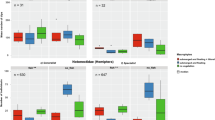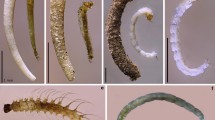Summary
We conducted a series of field experiments to examine the roles of refuge and food availability in explaining the distribution and abundance of fish in tidal freshwater marsh creeks. Two hypotheses were tested: (1) relative predation pressure is less in SAV than in unvegetated areas and (2) fish food availability is greater in SAV than in nearby unvegetated areas. Tethering experiments using mummichogs (Fundulus heteroclitus) in vegetated and unvegetated areas revealed that relative predation pressure was significantly less in areas with SAV. Banded killifish (Fundulus diaphanus) maintained in vegetated enclosures consumed prey associated with SAV, whereas those held in unvegetated pens had empty stomachs. No differences were found in the number of prey eaten by bluespotted sunfish (Enneacanthus gloriosus) or mummichogs when confined in vegetated or unvegetated enclosures. However, larger prey were consumed by bluespotted sunfish and mummichogs maintained in vegetated enclosures. These data suggest that foraging profitability is significantly enhanced by feeding in the SAV. Submerged plant beds in tidal freshwater marsh creeks not only afford protection from predators, but also provide a rich foraging habitat. By foraging in SAV, fish consume larger prey and may have higher growth rates, lower mortality, and higher fecundity.
Similar content being viewed by others
References
Bagenal TB (1978) Aspects of fish fecundity. In: Gerking SD (ed) Ecology of freshwater fish production. Blackwell, Oxford, pp 75–101
Boesch DF, Turner RE (1984) Dependence of fishery species on salt marshes: the role of food and refuge. Estuaries 7:460–468
Briggs PT, O'Connor JS (1971) Comparison of shore-zone fishes over naturally vegetated and sand-filled bottoms in Great South Bay. NY Fish Game J 18:15–41
Crowder LB, Cooper WE (1982) Habitat structural complexity and the interaction between bluegills and their prey. Ecology 63:1802–1813
Gerking SD (1962) Production and food utilization in a population of bluegill sunfish. Ecol Monogr 32:31–78
Gilinsky E (1984) The role of fish predation and spatial heterogeneity in determining benthic community structure. Ecology 65:455–468
Glass NR (1971) Computer analysis of predation energetics in the largemouth bass. In: Patten BC (ed) Systems analysis and simulation ecology. Academic Press, New York, pp 325–363
Graham JH, Hastings RW (1984) Distributional patterns of sunfishes on the New Jersey coastal plain. Environ Biol Fish 10:137–148
Hall DJ, Werner EE (1977) Seasonal distribution and abundance of fishes in the littoral zone of a Michigan Lake. Trans Am Fish Soc 106:545–555
Hall DJ, Cooper WE, Werner EE (1970) An experimental approach to the production dynamics and structure of freshwater animal communities. Limnol Oceanogr 15:839–928
Heck KL Jr, Thoman TA (1981) Experiments on predator-prey interactions in vegetated aquatic habitats. J Exp Mar Biol Ecol 53:125–134
Heck KL Jr, Thoman TA (1984) The nursery role of seagrass meadows in the upper and lower reaches of the Chesapeake Bay. Estuaries 7:70–92
Hellawell JM, Abel R (1971) A rapid volumetric method for the analysis of the food of fishes. J Fish Biol 3:29–37
Hull CH, Nie NH (1981) SPSS update 7-9. McGraw-Hill, New York, p 402
Kemp WM, Boynton WR, Twilley RR (1984) Influences of submersed vascular plants on ecological processes in upper Chesapeake Bay. In: Kennedy VS (ed) The estuary as a filter. Academic Press, Orlando, Florida, pp 367–394
Kislalioglu M, Gibson RN (1976) Some factors governing prey selection by the 15-spined stickleback, Spinachia spinachia (L.). J Exp Mar Biol Ecol 25:159–169
Lascara J (1981) Fish predator-prey interactions in areas of eelgrass (Zostera marina). MA thesis, College of William and Mary, p 81
Main KL (1987) Predator avoidance in seagrass meadows: prey behavior, microhabitat selection and cryptic coloration. Ecology 68:170–180
McIvor CC, Odum WE (1988) Food, predation risk and microhabitat selection in a marsh fish assemblage. Ecology (in press)
McIvor CC, Rozas LP, Odum WE (1988) Use of the marsh surface by fishes in tidal freshwater wetlands. In: Sharitz RR, Gibbons JW (eds) Freshwater Wetlands and Wildlife. U.S. Dept. of Energy Symposium Series (CONF-8603101). (in press)
Menzie CA (1980) The chironomid (Insecta: Diptera) and other fauna of a Myriophyllum spicatum L. plant bed in the lower Hudson River. Estuaries 3:38–54
Minello TJ, Zimmerman RJ (1983) Fish predation on juvenile brown shrimp, Penaeus aztecus Ives: the effect of simulated Spartina structure on predation rates. J Exp Mar Biol Ecol 72:211–231
Mitchell CT, Hunter JR (1970) Fishes associated with drifting kelp, Macrocystis pyrifera, off the coast of southern California and northern Baja California. Calif Fish Game 56:288–297
Mittelbach GG (1981) Foraging efficiency and body size: a study of optimal diet and habitat use by bluegills. Ecology 62:1370–1386
Nelson WG (1979) Experimental studies of selective predation on amphipods: consequences for amphipod distribution and abundance. J Exp Mar Biol Ecol 38:225–245
Orth RJ, Heck KL Jr (1980) Structural components of eelgrass (Zostera marina) meadows in the lower Chesapeake Bay fishes. Estuaries 3:278–288
Orth RJ, Heck KL Jr, van Montfrans J (1984) Faunal communities in seagrass beds: a review of the influence of plant structure and prey characteristics on predator-prey relationships. Estuaries 7:339–350
Power ME, Matthews WJ (1983) Algae-grazing minnows (Campostoma anomalum), piscivorous bass (Micropterus spp.), and the distribution of attached algae in a small prairie-margin stream. Oecologia (Berlin) 60:328–332
Rozas LP (1987) Submerged plant beds and tidal freshwater marshes: nekton community structure and interactions. Ph.D. Dissertation, University of Virginia, p 144
Rozas LP, Odum WE (1987a) Fish and macrocrustacean use of submerged plant beds in tidal freshwater marsh creeks. Mar Ecol Progr Ser 38:101–108
Rozas LP, Odum WE (1987b) Use of tidal freshwater marshes by fishes and macrofaunal crustaceans along a marsh stream-order gradient. Estuaries 10:36–43
Rozas LP, Odum WE (1987c) The role of submerged aquatic vegetation in influencing the abundance of nekton on contiguous tidal freshwater marshes. J Exp Mar Biol Ecol 1114:289–300
Savino JF, Stein RA (1982) Predator-prey interaction between largemouth bass and bluegills as influenced by simulated, submersed vegetation. Trans Am Fish Soc 111:255–266
Sokal RR, Rohlf FJ (1981) Biometry. Freeman, San Francisco, p 859
Stein RA, Magnuson JJ (1976) Behavioral response of crayfish to a fish predator. Ecology 57:751–761
Sullivan JF, Atchison GJ (1978) Predator-prey behavior of fathead minnows, Pinephales promelas, and largemouth bass, Micropterus salmoides, in a model ecosystem. J Fish Biol 13:249–253
Thayer GW, Stuart HH, Kenworthy WJ, Ustach JF, Hall AB (1978) Habitat values of salt marshes, mangroves, and seagrasses for aquatic organisms. In: Greeson PE, Clark JR, Clark JE (eds) Wetland functions and values: the state of our understanding. American Water Resources Association, Minneapolis, pp 235–247
Vince S, Valiela I, Backus N, Teal JM (1976) Predation by the salt marsh killifish Fundulus heteroclitus L. in relation to prey size and habitat structure: consequences for prey distribution and abundance. J Exp Mar Biol Ecol 23:255–266
Wankowski JWJ, Thorpe JE (1979) The role of food particle size in the growth of juvenile Atlantic salmon (Salmo solar L.). J Fish Biol 14:351–370
Watanabe JM (1984) The influence of recruitment, competition and benthic predation on spatial distributions of three species of kelp forest gastropods (Trochidae: Tegula). Ecology 65:920–936
Weisberg SB, Whalen R, Lotrich VA (1981) Tidal and diurnal influence on food comsumption of a salt marsh killifish Fundulus heteroclitus. Mar Biol 61:243–246
Werner EE (1986) Species interactions in freshwater fish communities. In: Diamond J, Case TJ (eds) Community ecology. Harper and Row, New York, pp 344–357
Werner EE, Gilliam JF (1984) The ontogenetic niche and species interactions in size-structured populations. Annu Rev Ecol Syst 15:393–425
Werner EE, Hall DJ (1974) Optimal foraging and the size selection of prey by the bluegill sunfish (Lepomis macrochirus). Ecology 55:1042–1052
Werner EE, Hall DJ (1976) Niche shifts in sunfishes: experimental evidence and significance. Science 191:404–406
Werner EE, Hall DJ (1977) Competition and habitat shift in two sunfishes (Centrarchidae). Ecology 58:869–876
Werner EE, Hall DJ, Laughlin DR, Wagner DJ, Wilsmann LA, Funk FC (1977) Habitat partitioning in a freshwater fish community. J Fish Res Board Can 34:360–370
Werner EE, Mittelbach GG, Hall DJ, Gilliam JF (1983) Experimental tests of optimal habitat use in fish: the role of relative habitat profitability. Ecology 64:1525–1539
Zaret TM (1980) Predation and freshwater communities. Yale University Press, New Haven, p 187
Zaret TM, Kerfoot WC (1975) Fish predation on Bosmina longirostris: body-size selection versus visibility selection. Ecology 56:232–237
Author information
Authors and Affiliations
Rights and permissions
About this article
Cite this article
Rozas, L.P., Odum, W.E. Occupation of submerged aquatic vegetation by fishes: testing the roles of food and refuge. Oecologia 77, 101–106 (1988). https://doi.org/10.1007/BF00380932
Received:
Issue Date:
DOI: https://doi.org/10.1007/BF00380932




